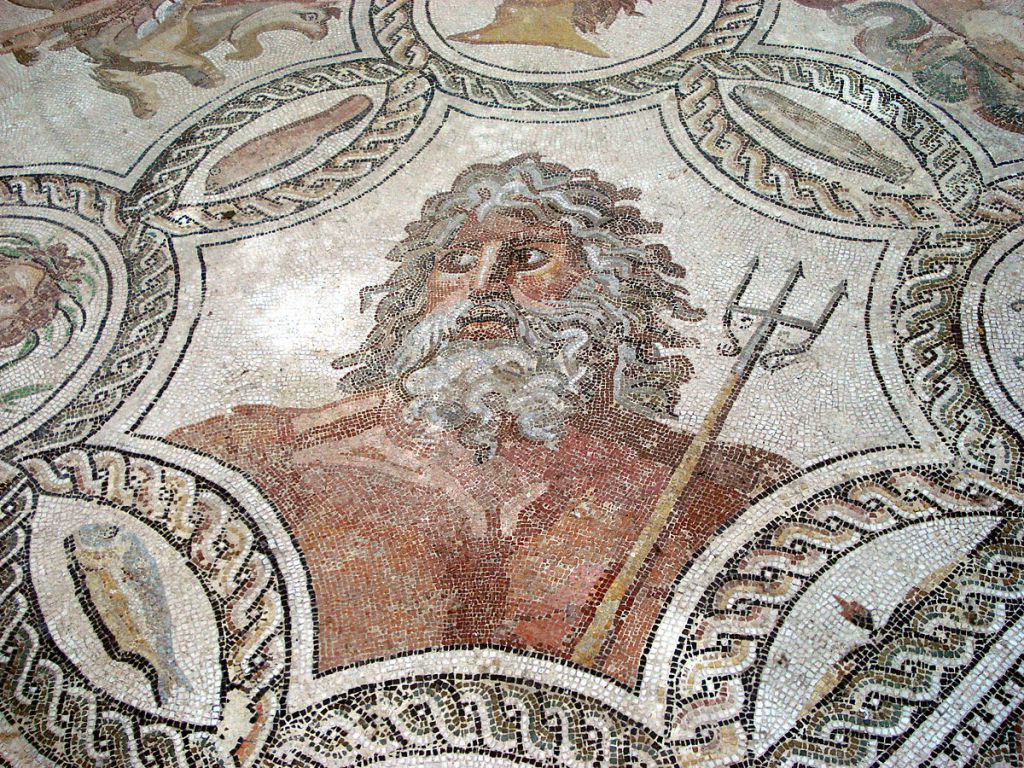Poseidon
Poseidon, often referred to as the God of the Sea, held dominion over various realms beyond just the ocean. In addition to being the master of the seas, he governed earthquakes, floods, droughts, and was revered as the divine patron of horses.

Residence: Mount Olympus or the Sea
Symbols: Trident, fish, dolphin, horse and bull
Parents: Cronus and Rhea
Siblings: Hestia, Hades, Hera, Demeter, Zeus and Chiron
Consort: Amphitrite, Aphrodite and Demeter
Children: Theseus, Triton, Polyphemus, Orion, Belus, Agenor and Neleus
Roman equivalent: Neptune
Artists often depicted Poseidon as a formidable figure, characterized by his mature appearance, robust physique, and a commanding presence. He was commonly portrayed with a dark, flowing beard and holding his iconic trident—a three-pronged spear that symbolized his power and authority over the waters.
As a central figure in Greek mythology, Poseidon played a significant role in shaping the natural world and influencing the destinies of mortals and immortals alike. His domain over the sea represented both its nurturing bounty and its destructive force, reflecting the dual nature of the ocean’s power. Poseidon’s association with earthquakes underscored his ability to unleash catastrophic events upon the earth, while his control over droughts and floods highlighted his influence over the cycles of nature.
Moreover, Poseidon’s affinity for horses emphasized his connection to the equestrian world, with these majestic creatures serving as symbols of strength, speed, and vitality.
Birth
Poseidon was one of the children of Cronus, the Titan ruler, and his wife Rhea. Like his siblings, Poseidon was swallowed by Cronus at birth as part of the Titan’s efforts to prevent his offspring from eventually overthrowing him, as prophesied. However, Zeus, Poseidon’s younger brother, managed to escape this fate and later orchestrated the liberation of his siblings.

Zeus sought the guidance of the goddess Metis, renowned for her wisdom and cunning. With her assistance, Zeus devised a plan to rescue his siblings from within Cronus. Metis concocted a powerful potion, which Zeus then tricked Cronus into consuming. The potion caused Cronus to experience intense discomfort, ultimately leading him to regurgitate the divine siblings—Poseidon, Hades, Hera, Demeter, and Hestia—whom he had swallowed.
This daring rescue marked a pivotal moment in Greek mythology, as it facilitated the eventual overthrow of the Titans and the ascent of the Olympian gods, with Zeus assuming leadership among them. Poseidon, freed from Cronus’s belly, went on to establish himself as one of the principal deities of Mount Olympus, presiding over the seas, storms, and earthquakes with formidable power and authority.
Athens
According to the myth, both Athena, the goddess of wisdom and warfare, and Poseidon, the god of the sea and earthquakes, sought to become the patron deity of the city of Athens.

In a competition to win the favor of the Athenians, each deity presented a gift to the city. Poseidon struck the ground with his trident, causing a spring to gush forth. However, the water from this spring was salty and not particularly useful to the Athenians. In contrast, Athena offered the Athenians an olive tree, a symbol of peace and prosperity. The olive tree provided not only food in the form of olives and olive oil but also wood for construction and various other practical uses.
The Athenians, recognizing the greater value of Athena’s gift, chose her as their patron deity. This decision led to the city being named Athens in honor of Athena. In his anger at losing the contest, Poseidon unleashed a monstrous flood upon the Attic Plain as a punishment for the Athenians’ decision. However, Athena intervened to protect her chosen city, and the floodwaters were eventually calmed.
Walls of Troy
According to the myth, Poseidon and Apollo, angered Zeus by participating in Hera’s rebellion or conspiracy. As a punishment for their disobedience, Zeus stripped them of their divine authority and sent them to serve King Laomedon of Troy. The king promised them a handsome reward for their service, but when the time came, he refused to fulfill his promise.

In retaliation for this betrayal, Poseidon, the god of the sea, sent a sea monster to attack the city of Troy. The monster wrought havoc and destruction upon the land, threatening the safety of its inhabitants. To rid the city of this menace, Laomedon promised to offer a reward to anyone who could slay the beast.
Heracles answered the call to action and succeeded in killing the sea monster, thereby saving Troy from further destruction. However, even after this heroic deed, Laomedon still refused to honor his promise to Heracles, leading to further conflict and tragedy.
Art









